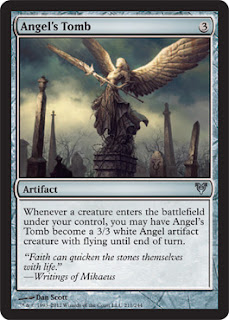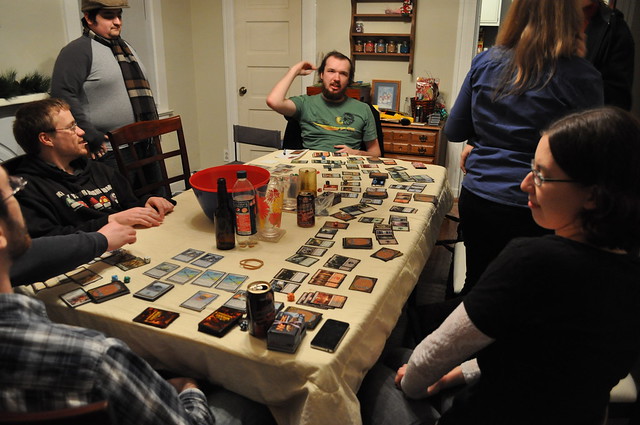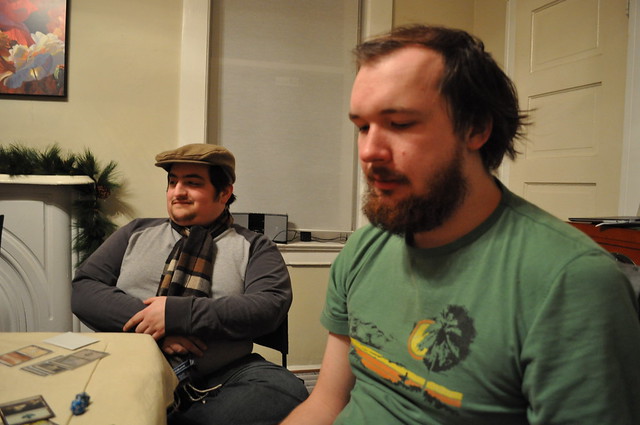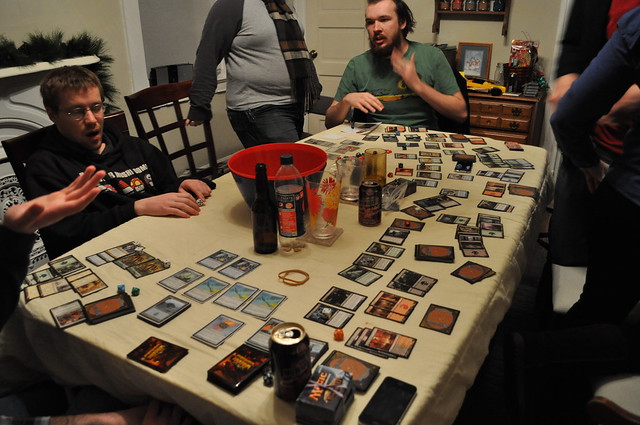Welcome back to another edition of Meat and Potatoes, Avacyn
Restored edition! This coming Saturday
is the Prerelease, and this time, we get a special treat. Normally, we only have one Prerelease a year
with only one set (save the summer Prereleases of Core editions of late), but
this year we get two! I like homogenous Prereleases
because they allow more consistent and intentional strategies. Although I had a fine finish last time, I
hope my blitz of Limited practice since then will have honed my skills to take
the cake.
Avacyn Restored is fairly separate from the block in terms
of mechanics; no Werewolves or flip cards, no Flashback and no Morbid. That’s because the angels under Avacyn have
been, uh, restored. I kind of like that
break from a block; Rise of the Eldrazi did the same thing. No landfall or kicker in there, if I recall;
just monstrous Cthulhu beasts.
The spoiler came out Monday and, either despite or because a
flush of illness, I was able to sit down and read the spoiler in its
entirety. The powerful cards that were
spoiled early seemed to have fairly specific purposes; the multi-colored cards
and massive mythics were all very expensive and splashy. Many players believe this is just how mythics
should be, and the “best” cards should be rare so they’re easier, but not cake,
to get. That’s the second time I’ve said
cake…I must be hungry.
The set looks like it’s going to give players of all brands
something to play with; EDH and Multiplayer/Variant lovers, tournament-cramming
Spikes, and a strong Limited game.
Limited, as it is of the most interest to me, will be our first stop.
As we look over the set of all 240-some-odd cards that were
spoiled Monday, let’s look and see what stands out as true Meat and Potato
cards for limited. As a reminder, Meat
and Potatoes cards are the basic, run-of-the-mill stuff that you’re bound to
see in a large portion of every Sealed tournament or booster draft in which you
participate; this leaves out rares and mythic rares, for the most part. In Limited, the commons and uncommons rule
and change the game. That’s why my Cube
only consists of those cards!
It was hard to cut down my Top Ten to just that many, so
we’ll begin with an honorable mention.
HM) Abundant Growth
 |
| These vines just splash all over! |
This little gem of an enchantment is a wonderful option for Limited
mana fixing. It solves a lot of problems
otherwise created by traditional ramp and color fixing. First, it provides benefit immediately (if
needed), unlike Rampant Growth, Birds of Paradise,
Terramorphic Expanse, etc. Those cards
are great, but they often lack relevance late in the game, which is when you’re
ripping for that answer or final few points of damage. This one is useful in an opening hand that
otherwise might be unkeepable AND
as a late-game topdeck. Thirdly, if you
just need a fix and you don’t know what you need yet, this will relieve your
woes. This is especially relevant in
Sealed when you just about have to play two colors and a splash (or two
splashes, ugh). I know I’ve stared at a
Terramorphic Expanse first turn and I wasn’t sure what land I’d need because of
my awkwardly color-heavy hand. This
solves that problem. Fix without the
mess, and it cantrips; that extra card really seals the deal. Seems pretty good. As a sidenote, I want to think this is Utopia
Sprawl, but it is not, and remember that, too!
Now…
10) Angel’s Tomb
 |
| Pretty art. Zero humor. |
A 3/3 flyer for 3 colorless mana is outstanding, but
desperately unlikely (though you can get a 3/2 flyer for 1 in Standard right
now; still trying to figure that one out.)
However, Angel’s Tomb fills a role in Limited that reminds me of Halcyon
Glaze, a legit 1UU Enchantment from Ravnica that turned into a 4/4 flying
Illusion instead. This is pretty
flexible, being colorless and all, and with all the ways to blink a creature in
and out, flashing a creature in, or through tokens, this will be active a fair
amount of the time, making it a slightly conditional, but still solid addition
to most any deck. You won’t want to
first pick it in Draft, but it seems like solid 4th or 5th
pick material, and it will be an inclusion in most any creature heavy deck in
Sealed.
9) Driver of the Dead
 |
| Driving Miss Zombie. |
This is an interesting card to me due to its specificity (as
opposed to the normally lauded flexibility of my choices,) but I think that the
card advantage as well as soulbond opportunities afford it a slot on the
list. He’s a big enough body too that he
chump-blocks well and you still get value.
There are certainly other better 4 drops, but he goes well in an
aggressive deck or a defensive deck all the same. He should make it around fairly late in Draft,
as there are only certain decks that will get to take advantage of him. Get back a utility creature, an undying
creature, or something else. Strangely
enough, I think this guy’s best fit is in R/B aggro or B/G.
8) Pillar of Flame
Woah, a Sorcery Shock. With an exile clause.
 |
| Groundbreaking. |
You might think this is weak, but as I surveyed the set, I’ve
found very little unconditional spot
removal outside of rares and mythics. White/Red
might actually catch a break this time around.
There are enough aggressively costed Humans in these colors to
constitute an early guess at a Limited archetype. Maybe this is just my bias talking, but I
just feel bad for these enemy colors that couldn’t effectively suit up in
either ISDx3 or DKA/ISD/ISD. Maybe
they’ll get a shot, and it’s little things like this that will help. It also gets rid of undying creatures before
they have a chance to undie, and provides desperately needed non-combat
interaction for aggro decks.
7) Ghostly Flicker
 |
| *Blink blink* |
I had a
whole deck for a while built around the blue/white blinking creatures of
Shadowmoor Block (Mistmeadow Witch + Mulldrifter, etc.) It was one of my favorite decks to play and,
for my opponents, one of the more frustrating decks to fight. Momentary Blink with an upgrade in flexibility,
the versatility of this spell is boundless in Limited. Untap two creatures after your opponent
attacks, wipe away an enchantment or prevent spell/lethal damage, reset ETB
effects or undying counters, choose new targets for a paired creature, untap a
land if you need that color of mana (very badly) or to use its effect again in
the case of the enemy-colored ability lands, or any number of niche roles. I’m sure I’m forgetting something, but this
is a great trick for any of the above roles, as well as those I’m missing. Blinking was always so undervalued in my
opinion, and Momentary Blink is continually one of my favorite cards to
facilitate this. It also only requires the
one color.
6) Nearheath Pilgrim
 |
| Lifelink really tips things in your favor. |
The only white card on this list (as most of the best cards
I’ve seen in White are rare or mythic), Nearheath Pilgrim seems to be a really
good card that requires a pinch of work to extract the most value. In the early game, he can provide a little
edge in a race by giving you a few points of life, forcing your opponent to
stay on defense while you develop your board.
In the late game, your largest creatures can get lifelink and bring you
back from the brink or secure your place in the lead. Not too much else to say about him. He obviously feels like Alabaster Mage, but I
think he provides a little more efficiency while requiring a little more skill
to play.
5) Wolfir Avenger
 |
| Khaaaaaaa....roooooo! |
One of the more exciting cards I found (my fondness for
Green notwithstanding), this guy might even see a hint of Constructed play in
Core Green decks when Thrun rolls out. A
flashable Trained Armadon that regenerates?
That seems pretty great in Limited and it fills a powerful role on both
offense and defense. The only
disadvantage is his mana commitment; two-color decks shouldn’t have a problem,
but three-color brews might want to steer clear; he’s best when you can
reliably cast him at the end of your opponent’s third or fourth turn or
mid-combat on those turns. Also, I don’t
know if this will make sense, but he just looks
like he’d be good. This is a skill I’ve
had a lot of trouble developing. Consider
Dark Confidant. I thought he was pretty
terrible when he came out six years ago.
Now, as a forty or fifty-dollar card and having played with one, I’ve realized my mistake. Wolfir Avenger looks good. Maybe it just
reminds me of Troll Ascetic or something.
4) Maalfeld Twins
 |
| Maalfeld better if he was a bit cheaper... |
This guy feels suspiciously like Grave Titan’s anemic
brother. Nevertheless, a strong 4/4 body
with a Moan of the Unhallowed on the tail end seems excellent in an aggressive
deck’s top-end. On defense, it also
provides three turns worth of chump blockers on the floor to dissuade attacks
from your opponent’s monster ground pounder.
Zombie synergies abound, and he could even find some weird place in a
low-tier Constructed Zombie deck. As I
wish for the Titans’ demise at the end of September this year, I hope there
will be more room for these conservative monsters to get their chance to
shine. If he was just one mana cheaper,
he might be first on this list.
3) Mist Raven
 |
| Oops, you mist your blocks. |
Mist Raven is built on a classic template; a simple and
effective mechanic with tons of applications and this time, we get an evasive
creature, all for the low, low price of four mana! I’m not sure if you should first pick this,
but in a weak pack with a whiff of a rare, I might. Blue looks pretty strong in the format, both
in Sealed and Draft. Aether Adepts and,
previously, Man O’ Wars have always been strong choices for their
tempo-swinging, two-for-oneish feel.
Load up on as many of these on the four slot as your deck will hold and
you’ll probably sweep your flight/pod.
2) Zealous Conscripts
 |
| Yankee doodle came to town, riding on a po...OH CRAP WHERE'S THE PONY?!?! |
Act of Treason on a stick!
A fairly solid stick, too. Most
of the time, the 3/3 for 4X cards in any given set are mediocre filler cards
(see Venser’s Sliver, Scourge Servant, or Tuktuk Grunts). Now, these
Conscripts know how to turn a game around.
Has your opponent stabilized at 10 life while they bludgeon you to death
with some monstrous Angel, or are you having trouble breaking through with a
clumsy board state? Have no fear, steal their
biggest guy and bash them right back!
The fact that you can target any permanent gives this even more
flexibility; remove control of some oppressive enchantment, land or
planeswalker and bend it as you need. Although
it is a rare and not completely unconditional, it IS a gamebreaker, and those
are the cards I like to have when I shuffle up 40.
1) Into the Void
 |
| Void where prohibited. |
Arguably the most textually boring card that may ever get to
#1, this card is vicious and utterly unfair.
Whiplash Trap busted so many games open in a grid-locked board that is
the definition of value. This is an
excellent choice against aggressive decks as well as powerfully defensive
decks, giving you the time to recover or the window to attack. Unsummon and its variants have always been a
fine choice. The fact that this hits two
creatures should always play on your mind; break paired creatures, erase
tokens, remove their entire defense, activate the “one creature matters” clauses
for your own creature. There is a lot of
power in this card. Even if it doesn’t
kill the creatures, they will need to spend two turns recasting them most
likely, and you’ll have two turns to recover or develop. It’s easily splashable and in a format
without tons of removal, this can be exactly the piece you need for your X/U
aggro puzzle. I don’t feel great about
this making the top seat, but I’m not sure what else would. In Dark Ascension, it was Tragic Slip (though
I might amend that to Lingering Souls now).
You WILL get a groan for your opponent as Into the Void resolves.
There are two new mechanics in this set of which a lot has
been written and discussed. The first, “soulbond,”
is a mechanic affiliated with certain creatures. When the creature with soulbond or any another
creature comes into play, you may pair these two creatures, so long as both are
otherwise unpaired. When paired, both of
those creatures receive a certain bonus.
I really like this mechanic.
Granted, it is only a Limited mechanic with few to no Constructed
applications, where each card needs to be fairly self-reliant. Still, it will offer some interesting
reactions within the game as well as some interesting drafting. You won’t want just creatures with soulbond,
as they can only bond to one creature at a time, so you’ll need to balance
bonding and unbonding creatures. I have
no idea what that balance should be – eight bonding to eight unbonding? I’m not sure.
It will take a fair amount of playtesting to see how many is too many.
Next, the “miracle” mechanic allows you to cast some
nonpermanent spells immediately as you draw them, so long as it’s the first
card you draw that turn, drastically reducing the cost and allowing you to play
sorceries with miracle during your draw step.
I’m really not sure how I feel about this; it’s begging to be broken,
especially in Constructed. It adds a
certain level of luck to a game where good players try to minimize luck’s role
in the game. That being said, it will
create some great Limited stories and
it can be strategic; you can still wait to hard cast the spell later, if you
feel it would be more prudent. I didn’t
put any of them in the Top Ten because I was unsure how to evaluate their power
level. It’s obvious that Temporal
Mastery is just straight up Time Walk in Miracle land, and you can be sure that
Ponder will slide that in the right place every time. Thunderous Wrath, the Lava Axe Miracle, has
also garnered some attention. RDW decks
will rarely pass up the chance to Lava Axe you for R. I also believe that Banishing Stroke will be
strong in Limited and some Constructed play as an instant O-Ring. It’s also important to note that if you cast
something for its Miracle cost, your opponent knows that you have not added a new
card to your hand; if you couldn’t deal with something before you drew the
Miracle card, they still can’t deal with it if the Miracle card didn’t fix
it. This is valuable information in a
Limited space, especially where both players are out of gas and have to
strategically the contents of a player’s deck and hand.
I’ll be playing up at Bluegrass Magic in Louisville this weekend, and I hope to see a
big turn out! I hope you have fun at
your Prerelease, too, as we chalk up another set to the annals of Standard. Expect to see a Prerelease report from me
next week.
Oh, and cake.
Until next time, don’t forget to untap!
- Matt







